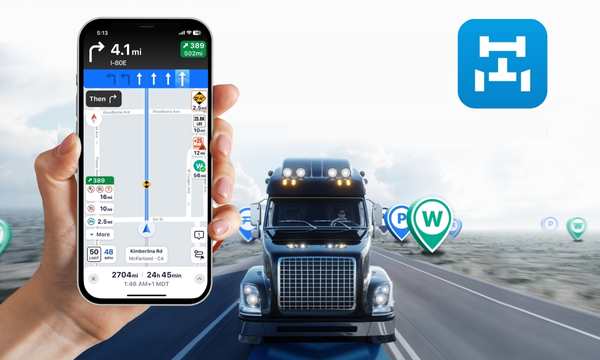Integration of GPS Applications with Fleet Tracking Systems
In the dynamic world of transportation, operational effectiveness is crucial for success.
Ad
One of the most significant advancements in this area is the integration of GPS applications with fleet tracking systems.
This article explores how this integration can transform fleet tracking, offering benefits ranging from real-time monitoring to performance optimization.
Ad
Garmin GPS Navigators
Garmin GPS navigators are portable or vehicle-installed devices that use the Global Positioning System (GPS) to assist in navigation.
They provide information about your current location, route, and destination, as well as other useful features such as points of interest (POIs), traffic alerts, and speed cameras.
Additional Features:
- Detailed Maps: Garmin navigators come with preloaded maps of your region, with the option to download additional maps for other countries or regions.
- Points of Interest (POIs): POIs are locations such as restaurants, gas stations, hotels, and tourist attractions that can be marked on the map and easily found by the navigator.
- Traffic Alerts: Garmin navigators with traffic reception can receive real-time information about congestion and road conditions, allowing you to avoid traffic jams and find alternative routes.
Real-Time Monitoring
Integrating GPS applications with fleet tracking systems allows companies to track the exact location of each vehicle in real-time.
This continuous monitoring provides a comprehensive view of operations, enabling more proactive and responsive management.
With instant access to truck positions, managers can make quick, informed decisions, improving route efficiency and minimizing delays.
Moreover, this real-time visibility is critical for responding to emergencies or unexpected deviations.
If a truck encounters road issues such as an accident or a blockage, managers can intervene immediately.
They can contact the driver, provide alternative directions, and ensure that the delivery is made with minimal delay.
This ability to respond quickly not only enhances operational efficiency but also increases customer satisfaction by ensuring reliable and timely deliveries.
This powerful combination provides fleet managers with a complete and comprehensive view of operations, enabling precise and proactive control over various aspects:
- Real-time Location: Monitor the exact position of each truck at any time, ensuring total visibility over the fleet.
- Embarazo +Driver Performance: Analyze data such as average speed, stop times, and fuel consumption to identify optimization opportunities and driver training.
- Route Conditions: Access information on road conditions, congestion areas, and potential closures, allowing for more efficient and safe route planning.
- Delivery Management: Track delivery statuses in real-time, updating clients and optimizing logistics processes.
- Enhanced Safety: Identify risky driving behaviors such as speeding or harsh braking, promoting driver and cargo safety.
- Instant Communication: Communicate with drivers in real-time, providing updated instructions in case of emergencies or necessary deviations.
Data Analysis for Optimization
One of the greatest benefits of integrating fleet tracking systems with GPS applications is the ability to collect and analyze vast amounts of data.
Detailed information on average speed, fuel consumption, stop times, and driver behavior is recorded and can be analyzed to identify areas for improvement.
For example, by monitoring vehicle average speeds, managers can identify driving patterns that negatively impact fuel consumption.
Drivers who drive aggressively, with rapid accelerations and abrupt stops, tend to consume more fuel.
With this data in hand, managers can implement specific training programs to improve driver behavior, resulting in fuel savings and reduced operational costs.
Similarly, analysis of stop times can reveal inefficiencies in routes or in the loading and unloading process.
Identifying frequent and prolonged stops allows managers to adjust routes or make logistics process improvements, optimizing operation time and increasing fleet productivity.
Effective Communication
Communication between managers and drivers is essential for a successful transportation operation.
The integration of fleet tracking systems with GPS applications significantly enhances this communication.
In case of route changes or emergencies, managers can send messages directly to drivers, ensuring they receive necessary information quickly and efficiently.
Moreover, this efficient communication allows managers to provide constant updates on road conditions, weather changes, and other variables that may affect the journey.
With this information, drivers can adjust their routes and travel plans, avoiding delays and ensuring delivery safety.
Resource Management Improvement
Integration with fleet tracking systems also facilitates better allocation and utilization of company resources.
With a clear view of where each vehicle is and how it is being used, managers can plan preventive maintenance more efficiently.
Vehicles that travel longer distances or operate in harsh conditions can be scheduled for maintenance based on actual usage, rather than fixed time intervals, prolonging vehicle life and reducing maintenance costs.
Furthermore, the ability to track driver performance allows managers to identify top performers and those needing improvement.
Drivers who consistently follow best practices can be rewarded, while those needing improvement can receive additional training.
This not only improves individual driver performance but also promotes a culture of excellence and safety within the company.
Sustainability and Environmental Responsibility
With increasing pressure for companies to adopt more sustainable practices, the integration of fleet tracking systems with GPS applications can play a significant role in reducing carbon footprint.
By optimizing routes and improving fuel efficiency, companies can significantly reduce their CO2 emissions.
Additionally, the ability to monitor and reduce fuel consumption contributes to conservation of natural resources and reduces reliance on fossil fuels.
Companies demonstrating a commitment to sustainability can benefit from improved reputation and greater customer loyalty.
In a market where consumers are increasingly concerned about environmental issues, adopting sustainable practices can be a significant competitive advantage.
Conclusion
The integration of GPS applications with fleet tracking systems is a transformative innovation in the transportation sector.
By providing real-time monitoring, detailed data analysis, efficient communication, and better resource management, this integration offers substantial benefits that can improve operational efficiency, reduce costs, and increase customer satisfaction.
Furthermore, by contributing to more sustainable practices, this technology helps companies meet growing demands for environmental responsibility.
For transportation companies looking to stand out in a competitive market, adopting this integration is not only recommended but essential.
Remember: GPS and FTS integration is just the beginning. It is essential for the company to have a data-driven culture and use generated information to make strategic decisions and promote continuous operational improvement.
 Trucker Path App: Optimized Routes and Fuel
Trucker Path App: Optimized Routes and Fuel
Trucker Path: Plan routes, save fuel, and dominate the road! Ad Whether you’re an experienced trucker or […]
More App Clearblue: Learn How to Monitor Your Pregnancy Safely
App Clearblue: Learn How to Monitor Your Pregnancy Safely
Discover the Clearblue app and how it can help you during your pregnancy. Ad Let’s dive into […]
More Get Vehicle Information: What You Need to Know
Get Vehicle Information: What You Need to Know
Consult vehicle information quickly and easily! Get the data you need without the hassle! Ad Checking vehicle […]
More